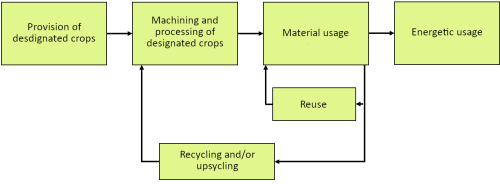Examples for cascading use
Arnold et al. (2009) define cascading use as "sequential use of biogenic raw materials for material and energetic applications" (p. 18).
Kaskadennutzung von NawaRo, Quelle: own illustration based on Arnold et al. 2009
The BMELV (BMELV 2008) distinguishes between two types of cascading use (p.1):
- Biomass is first used materially, possibly over several stages of use or over several products, and is then utilised energetically at the end of the product cycle.
- Biomass is first used as a material, possibly over several stages of use or over several products, and then recycled as a material. After one or more recovery cycles, energy can be used or, in the case of biodegradable products, composting can take place if necessary".
Typically, cascading use takes place in the area of forestry biomass: Trunk wood is not used directly for energy purposes. Instead, it is made available as building material. At the end of the first life cycle (construction timber) either the energetic use or one or more life cycles follow, in which the raw material is used again materially (e.g. as furniture, chipboard, in the fibre-based or chemical industry). The last stage here is also the energetic use (Höglmeier 2015).
See also: www.tum.de
When using cascades, it should be noted that raw material quality and energy content may decrease as the cascades increase and that additional sorting and processing steps are usually necessary (e.g. removal of varnish and other pollutants from waste wood).
Reflect contributions from the media on competing uses. Are there really any competition for use? How can these be addressed?
Think about possible utilisation paths for a biomass of your choice, especially with regard to cascading use or utilisation of by-products.
